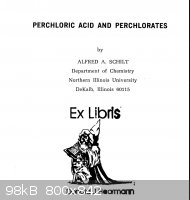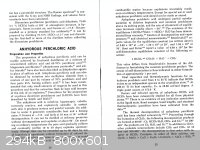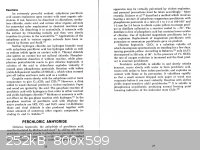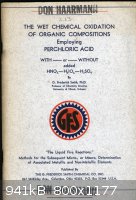| Pages:
1
2 |
garage chemist
chemical wizard
    
Posts: 1803
Registered: 16-8-2004
Location: Germany
Member Is Offline
Mood: No Mood
|
|
urea perchlorate
I'll soon get some KClO4 and distill 72% (azeotropic, nonexplosive) Perchloric acid from this.
Urea perchlorate hasn't been covered before, so let's discuss it. I never saw a procedure for it either.
It could be made by mixing dilute solution of HClO4 with conc. solution of urea and filtering (if it has low solubility) or evaporating the solution.
Will this be a primary or secondary HE?
|
|
|
PainKilla
Hazard to Others
  
Posts: 306
Registered: 29-4-2004
Member Is Offline
Mood: No Mood
|
|
It probably doesn't exist, on top of that it is damn near impossible to get HClO4 from KClO4. You are better off starting from NaClO4. That is
the procedure used for making it usaully. Only problem is that IIRC its explosive too and not very cheap. On top of that, I don't see how urea
perchlorate would even be possible. Carbamide Percholate? Unlikely. :p
|
|
|
chemoleo
Biochemicus Energeticus
    
Posts: 3005
Registered: 23-7-2003
Location: England Germany
Member Is Offline
Mood: crystalline
|
|
Nono, urea forms nitrates too, which is fairly insoluble, so there is no reason why perchlorates couldn't form. There is however a description of
guanidine perchlorate somewhere (which is better), and ethylendiamine perchlorate, even hydrazine perchlorate. The latter three have known VoDs, they
are quite high.
From my experience with nitrate salts of amines, the perchlorates should be more sensitive, but very hygroscopic.
So you want to distill HClO4? make sure it is dilute.
Why wouldnt it work, Painkilla, i.e. dil H2So4 + KClO4? It would be slower than with NaClo4, granted, but should still work.
Never Stop to Begin, and Never Begin to Stop...
Tolerance is good. But not with the intolerant! (Wilhelm Busch)
|
|
|
PainKilla
Hazard to Others
  
Posts: 306
Registered: 29-4-2004
Member Is Offline
Mood: No Mood
|
|
I remember trying to find a way to do it myself but coudln't find one. Ill try to pull up a few references..... It can be done but it is very
difficult to actually do, especially with KClO4.
Fixed.
link
[Edited on 28-1-2005 by PainKilla]
|
|
|
garage chemist
chemical wizard
    
Posts: 1803
Registered: 16-8-2004
Location: Germany
Member Is Offline
Mood: No Mood
|
|
72% Perchloric acid has a constant boiling point of 203°C at atmospheric pressure and is not classified as being explosive. It has an oily
consistency and looks exactly like conc. H2SO4.
However, the anhydrous acid (which has a low viscosity) explodes on warming even before it reaches its boiling point and can also spontaneously
detonate at room temp. without any obvious reason. It can only be distilled in vacuum and with extreme safety measurements.
NaClO4 seems to be very difficult to get, because most suppliers only sell NH4ClO4 and KClO4. The former could be boiled with NaOH though.
KClO4 can not be transformed into any other perchlorate salt by recristallisation, because of its very low solubility. Hence the need to make HClO4.
|
|
|
BromicAcid
International Hazard
    
Posts: 3264
Registered: 13-7-2003
Location: Wisconsin
Member Is Offline
Mood: Rock n' Roll
|
|
Gahhh, someone fix the above links!
Distilling perchloric acid is no easy task as you've probably already read, how is he going to make sure the HClO4 is dillute Chemoleo if
he's distilling, the azeotrope will come over, or do you mean to say he should make sure he dillutes it before reacting it with the urea?
As I've already posted in the perchloric acid thread I've tried this (prep of HClO4 from KClO4 with H2SO4) with limited sucess, if you want
I could U2U you specifics.
Edit: My post kind of overlaps with the above, be sure to distill under reduced pressure, at atmospheric pressure up to 20% of the HClO4 can
decompose and explosions have known to result, even a speck of dust can cause them.
[Edited on 1/28/2005 by BromicAcid]
|
|
|
chemoleo
Biochemicus Energeticus
    
Posts: 3005
Registered: 23-7-2003
Location: England Germany
Member Is Offline
Mood: crystalline
|
|
Garagechemist, there is a prep on the production of HClO4 from KClO4 using H2SO4.
For details (and since you can read German), have a look at Brauer's inorganic chemistry preps, page 327 (Vol 1). You can download it from the
FTP.
If someone wants more details let me know.
| Quote: |
It probably doesn't exist,
|
Be careful with such statements if there is no evidence...
Never Stop to Begin, and Never Begin to Stop...
Tolerance is good. But not with the intolerant! (Wilhelm Busch)
|
|
|
S.C. Wack
bibliomaster
    
Posts: 2419
Registered: 7-5-2004
Location: Cornworld, Central USA
Member Is Offline
Mood: Enhanced
|
|
...especially when a search of google and espacenet reveals its preparation and use in explosive compositions.
[Edited on 2-2-2005 by S.C. Wack]
|
|
|
Axt
National Hazard
   
Posts: 856
Registered: 28-1-2003
Member Is Offline
Mood: No Mood
|
|
PATR listing of Urea Perchlorate (I havn't fixed the spelling errors due to OCR):
| Quote: | CH5CI.N205,; mw 160.52;
N 17.46%; OB to C02 +4.98%; v hydroscopic and unstable white crysts; mp, explds on heating without burning. V sol in w. CA Registry No [1872-07-6].
Prepn is by the interaction of equimolar amounts of urea and perchloric acid in acetic acid followed by solvent evapn. Its
impact sensy is comparable to that of TNT
(Refs 1 and 17a) The perchlorate has been incorporated into
more than several expl compns. Shiino et al claim in their patent (Ref 23) that a liq expl of high deton vel can be made by dissolving solid aromatic
nitro compds into aq urea perchlorate.
Thus, PA (5) is dissolved in 85% aq urea perchlorate (95 wt p) to obtain a liq expl having a d of 1.6g/cc and a deton vel of 6520rn/sec. In the
invention of Fujiwara et al (Ref 24) an expl slurry of improved stability is claimed consisting of a mixt of combustible solids in aq urea perchlorate
soln. Typically, powdered K perchlorate
(30) and powdered ferrosilicon (30) are
added to 85% aq urea perchlorate (50 wt p) to form a slurry-like expl having a d of 1.7 lg/cc and a deton vel of 3700m/see, as well as high stability.
In another patent, Shiino et al (Ref 25) claim a process for the prepn of the expl
perchlorate, per se. Thus, 430g of urea are added slowly to 1000gof715Z0 aq perchloric acid at <20° to give the 1:1 urea perchlorate salt crysts.
The patent shown in Ref 26 suggests the use of the perchlorate in an underwater blasting slurry when incorporated with materials
such as PA. The claimed impact sensy is > 60cm (5-kg wt from 60cm resulting in 0/6 trials).
Fujiwara et al, as a result of their work, (Refs 29& 30) with aq urea perchlorate solns mixed with various organic substances, report that with
detonatable materials such as PA, the solns
formed are impact insensitive but powerful
expls exhibiting two distinct deton modes: low vel deton (LVD) (’u 1900rn/see) and high vel deton p 6000m/see). Mixts with nondetonatable
substances as ~trobenzene or dimethylformamide show only LVD, requiring an extremely high critical initiation pressure of approx 40kbar.
|
|
|
|
AndersHoveland
Hazard to Other Members, due to repeated speculation and posting of untested highly dangerous procedures!
    
Posts: 1986
Registered: 2-3-2011
Member Is Offline
Mood: No Mood
|
|
There is a big russian explosives site that claims that when urea perchlorate is ground in a mortar and pestle there are little popping sounds,
presumably as the little granules detonate, so it is probably advisable to be fairly careful when handling energetic perchlorate salts. Here is a link
to the site, but be WARNED, despite the site having a huge library of information and decent content, it is also, for some reason, smeared in
pornographic video pictures, not to mention that the entire site is in russian.
http://www.pirotek.info/Vv2/oktonitrocuban.htm
[Edited on 29-6-2011 by AndersHoveland]
I'm not saying let's go kill all the stupid people...I'm just saying lets remove all the warning labels and let the problem sort itself out.
|
|
|
The WiZard is In
International Hazard
    
Posts: 1617
Registered: 3-4-2010
Member Is Offline
Mood: No Mood
|
|
Amazing what floats to the surface here...!
You can read H H Willard original preparation of perchloric
acid 1912 from ammonium perchlorate in the J. Amer. Chem. Soc.,
34, 1480 @ Google.com/books.
http://tinyurl.com/5vxo2v4
|
|
|
woelen
Super Administrator
        
Posts: 8060
Registered: 20-8-2005
Location: Netherlands
Member Is Offline
Mood: interested
|
|
I cannot read that link, apparently it only is accessible if you're from the US. Is it possible to extract a PDF and post that? I have quite some
ammonium perchlorate (we can buy that over here without too much hassle, as long as it is in the form of somewhat bigger crystals) and if HClO4 can be
made from that in a safe way then I would like to know of that.
|
|
|
Rosco Bodine
Banned
Posts: 6370
Registered: 29-9-2004
Member Is Offline
Mood: analytical
|
|
The preparation of perchloric acid Willard JACS 34, 1480, 1912
Attachment: The preparation of Perchloric acid.pdf (431kB)
This file has been downloaded 1221 times
|
|
|
The WiZard is In
International Hazard
    
Posts: 1617
Registered: 3-4-2010
Member Is Offline
Mood: No Mood
|
|
This me thinks dobe a easier synthesis. Brauer is in la Science Most Mad's library.
The Merck Index
Monograph Number: 0007153
Title: Perchloric Acid
CAS Registry Number: 7601-90-3
Molecular Formula: ClHO4
Molecular Weight: 100.46
Percent Composition: Cl 35.29%, H 1.00%, O 63.70%
Line Formula: HClO4
Literature References: Prepd from potassium perchlorate and
sulfuric acid: Schmeisser in Handbook of Preparative Inorganic
Chemistry vol. 1, G. Brauer, Ed. (Academic Press, New York, 2nd
ed., 1963) pp 318-320. Comprehensive monograph: J. C.
Schumacher, Perchlorates (Reinhold, New York, 1960).
Properties: The anhydr acid is a colorless, volatile, very
hygroscopic liquid. d22 1.768; bp11 19°. Dec when distilled at
atmospheric pressure, sometimes with explosive violence. mp -
112°. Combines vigorously with water with evolution of heat.
Undergoes spontaneous and explosive decompn, hence it is
marketed only in mixture with water contg 60-70% HClO4, density
1.5 and 1.6, respectively. The aq acid is very caustic and may
deflagrate in contact with oxidizable substances. Density of aq
solns at 15°: 1% = 1.0050; 10% = 1.0597; 20% = 1.1279; 30%
= 1.2067; 40% = 1.2991; 50% = 1.4103; 60% = 1.5389; 70% =
1.6736. Density of aq solns at 25°: 65.0% = 1.597; 70.0% =
1.664; 75.0% = 1.731.
Melting point: mp -112°
Boiling point: bp11 19°
Density: d22 1.768; Density of aq solns at 15°: 1% = 1.0050;
10% = 1.0597; 20% = 1.1279; 30% = 1.2067; 40% = 1.2991;
50% = 1.4103; 60% = 1.5389; 70% = 1.6736.
CAUTION: Corrosive to skin, mucous membranes.
Use: The acid in analytical chemistry as an oxidizer and for
separation of potassium from sodium. Its salts for explosives and
for plating of metals.
---
Add a little excitement to your chemistry with anhydrous perchloric
acid.
If you have, dobe knowing someone who has? Yes. An academic
affiliation you maybe able to get a free copy of these from
GF Smith Chemical Company.
If'n you do — perhaps you can obtain a second copy (it is a newer version of my copy) of —
Perchloric Acid and Perchlorates, for me.
Thanks.
   
|
|
|
quicksilver
International Hazard
    
Posts: 1820
Registered: 7-9-2005
Location: Inches from the keyboard....
Member Is Offline
Mood: ~-=SWINGS=-~
|
|
RE: the pamphlet, how old was it & was it a 4 page academic hand-out? I still have a few friends who are teaching.
I never bothered with it personally. A plating company in town had a great deal of it (60-70% acid) & it was very inexpensive.
|
|
|
The WiZard is In
International Hazard
    
Posts: 1617
Registered: 3-4-2010
Member Is Offline
Mood: No Mood
|
|
Quote: Originally posted by quicksilver  |
RE: the pamphlet, how old was it & was it a 4 page academic hand-out? I still have a few friends who are teaching.
I never bothered with it personally. A plating company in town had a great deal of it (60-70% acid) & it was very inexpensive.
|
Perchloric Acid and Perchlorates 1979, I believe they have a newer
edition is 189 pages.
The Wet Chemical Oxidation... 1965, 105 pages.
V/ v/ difficult to find outside a library though it has been
reprinted by UMI Books on Demand (of which my copy is.), but still v/ v/ useful —
J Schumacer Ed.
Perchlorates: Their Properties, Manufacture and Uses
Reinhold Publishing
1960
---
Maybe of use —
Accession Number : AD0242192
Title : CHLORATES AND PERCHLORATES THEIR MANUFACTURE,
PROPERTIES AND USES
Corporate Author : SOUTHWEST RESEARCH INST SAN ANTONIO TX
Personal Author(s) : WARREN, FRANCIS A. ; MILLAR, JOHN D.
Handle / proxy Url : http://handle.dtic.mil/100.2/AD242192
Report Date : 15 MAY 1960
Pagination or Media Count : 754
Descriptors : *CHLORATES, *PERCHLORATES, PRODUCTION,
CHEMICAL PROPERTIES, SYNTHESIS(CHEMISTRY), EXPLOSIVES,
CHEMICAL REACTIONS, PYROTECHNICS.
Subject Categories : INORGANIC CHEMISTRY
INDUSTRIAL CHEMISTRY AND CHEMICAL PROCESSING
I bought a 35mm microfilm copy (the only version available)
from the NTIS years ago (US #4.00). I never found the need to
spend US $300 or so for a blow back. I could have run it through
my Nikon Coolscan 5000 (Don't buy one!).... lets see 754 pages
times 133 meg. per page equals .... X-bytes... lots of bytes.
If'n you search la DTIC you will find a pub on the production
of perchlorates by chemical means, I have found it interesting,
if not useful.
I just shit-canned my blow back from microfiche (at the time
MF's were only US $4.00 from the NTIS compared to YAHOO $$ for
a print version) on that old time slimy/heavy paper of ....
Accession Number : AD0900260
Title : Engineering Design Handbook. Principles of Explosive Behavior
Descriptive Note : Pamphlet
Corporate Author : ARMY MATERIEL COMMAND ALEXANDRIA VA
Handle / proxy Url : http://handle.dtic.mil/100.2/AD900260
Report Date : 10 APR 1972
Pagination or Media Count : 381
Abstract : This document contains reports on: (1) Energy of
explosives, (2) Thermal decomposition of explosives, (3)
Measurement of detonation properties, (4) Elementary theory of
the plane detonation wave, (5) Application of theory to condensed
explosives, (6) Structure of the plane detonation wave: finite
reaction zone, (7) Detonation waves of cylindrical and spherical
symmetry, (8) Thermal explosion, (9) Initiation of detonation by
shock waves, (10) Initiation and growth of detonation from impact,
friction, and thermal sources, (11) Shock waves from explosive
charges, and (12) Computer programs for explosive calculations.
Descriptors : *EXPLOSIVES, X RAY PHOTOGRAPHY,
FRAGMENTATION, LIQUIDS, THERMODYNAMICS, SHOCK WAVES,
EXPLOSIVE CHARGES, GASES, THERMOCHEMISTRY, HANDBOOKS,
FRICTION, DECOMPOSITION, HYDRODYNAMICS, PYROLYSIS,
DETONATIONS, EQUATIONS OF STATE, UNDERWATER, RADIATION
EFFECTS, COMPUTER PROGRAMS, REACTION KINETICS
Subject Categories : AMMUNITION AND EXPLOSIVES
NB — This is not a how-to book, it is? Yes! Tres technical.
|
|
|
dann2
International Hazard
    
Posts: 1523
Registered: 31-1-2007
Member Is Offline
Mood: No Mood
|
|
'The Perchlorates' is available here:
http://www.archive.org/details/pwechloratesthei001740mbp
Thanks for 'The Chlorates and Perchlorates' Mr. Wizard.
Seen a ref. to it years ago but was always unable to find it.
Perchloric acid (book) is available for viewing here:
http://babel.hathitrust.org/cgi/pt?id=uc1.l0064462088
Anyone know how to download the thing.
Perchloric acid and Perchlorates can be had from Amazong for 27.50 Dollars.
I enclose 'Perchloric acid' from Russian Journal for your enjoyment.
Dann2
[Edited on 30-6-2011 by dann2]
Attachment: perkacid.pdf (1.9MB)
This file has been downloaded 1112 times
[Edited on 30-6-2011 by dann2]
|
|
|
AndersHoveland
Hazard to Other Members, due to repeated speculation and posting of untested highly dangerous procedures!
    
Posts: 1986
Registered: 2-3-2011
Member Is Offline
Mood: No Mood
|
|
I had always suspected that anhydrous aluminum perchlorate might be explosive, but despite devoting several paragraphs to this compound, they do not
mention anything about it being explosive.
section containing some information about perchloric acid here:
https://sites.google.com/site/energeticscribble/perchloric-a...
it is not intended to be comprehensive or completely reliable, but perhaps one of you will find something interesting
I'm not saying let's go kill all the stupid people...I'm just saying lets remove all the warning labels and let the problem sort itself out.
|
|
|
franklyn
International Hazard
    
Posts: 3026
Registered: 30-5-2006
Location: Da Big Apple
Member Is Offline
Mood: No Mood
|
|
4 parts (H2N)2CO • HClO4 to one part CH3NO2 by weight is oxygen balanced
and Velocity of detonation is ~ 6500 m/s
3 (H2N)2CO • HClO4 + 2 CH3NO2 => 5 CO2 + 9 H2O + 3 HCl + 4 N2
Attachment: Urea Perchlorate Nitromethane US4047987.pdf (951kB)
This file has been downloaded 1020 times
Attachment: Urea Perchlorate Nitromethane GB2080280.pdf (443kB)
This file has been downloaded 989 times
Commercially NH4ClO4 is made by dissolving NH4Cl with NaClO4 in water.
The less soluble NH4ClO4 precipitates and is filtered off, leaving NaCl in solution.
See => PATR 2700, P 146
Crystallization of Ammonium-Perchlorate from Solution of
Electrolytically Produced Sodium-Perchlorate in a Pilot Scale Plant
www.nt.ntnu.no/users/skoge/prost/proceedings/ecce6_sep07/upl...
www.soapgoods.com/Ammonium-Chloride-p-773.html
http://smokechemicals.com/shop/index.php?main_page=product_i...
NH4ClO4 can be also made by dissolving (NH4)2SO4 with KClO4 in water,.
(NH4)2SO4 + 2 KClO4 => K2SO4 + 2 NH4ClO4
See => Attachment: Solubilities of alkali metal perchlorates at 25 C & NH4ClO4 Prep.rtf (10kB)
This file has been downloaded 953 times
www.soapgoods.com/Ammonium-Sulfate-p-714.html
http://smokechemicals.com/shop/index.php?main_page=product_i...
In the same way to make (H2N)2CO • HClO4 , neutralize muriatic acid (36 % HCl solution )
with Urea, then mix in the stoichiometric amount of NaClO4.
(NH2)2CO • HCl + NaClO4 => NaCl + (NH2)2CO • HClO4
See the patent US4047987above
Activity Coefficients of Hydrochloric Acid in Hydrgen Chloride Metal Perchlorate Water Systems
http://pdf.lookchem.com/pdf/22/73c04100-f498-4ab9-a4ee-44af8...
NH4ClO4 can be used instead
(NH2)2CO • HCl + NH4ClO4 => NH4Cl + (NH2)2CO • HClO4
www.soapgoods.com/Urea-Prilled-Commercial-p-751.html
www.hobbychemicalsupply.com/servlet/the-123/Ammonium-Perchlo...
In Methanol or Acetone the opposite occurs , NaCl is practically insoluble in those
solvents but (H2N)2CO • HClO4 is solvated. It is possible to use KClO4 instead
in this way (NH2)2CO • HCl + KClO4 => KCl + (NH2)2CO • HClO4
www.soapgoods.com/Urea-Prilled-Commercial-p-751.html
http://smokechemicals.com/shop/index.php?main_page=product_i...

Perchloric acd from NH4ClO4 oxidation
http://thesis.library.caltech.edu/4743
http://thesis.library.caltech.edu/4743/1/Adams_hc_1925.pdf
_______________________________________________________
@ AndersHoveland
Al(ClO4)3 • 6 N2H4
Attachment: Al & Mg Perchlorate Hydrazine cmplexes US4053567.pdf (316kB)
This file has been downloaded 986 times
.
|
|
|
Rosco Bodine
Banned
Posts: 6370
Registered: 29-9-2004
Member Is Offline
Mood: analytical
|
|
It would probably be interesting to see if double decomposition occurs upon mixing urea nitrate and ammonium perchlorate, perhaps slurrying with
minimal water or maybe a little 91% isopropanol and warming.
Ammonium perchlorate added to a melt of ammonium nitrate and urea as a slurry with urea nitrate might also undergo a double decomposition where the
urea perchlorate forms in situ in considerable amount and the resulting reaction mixture may be a useful explosive.
[Edited on 1-7-2011 by Rosco Bodine]
|
|
|
AndersHoveland
Hazard to Other Members, due to repeated speculation and posting of untested highly dangerous procedures!
    
Posts: 1986
Registered: 2-3-2011
Member Is Offline
Mood: No Mood
|
|
Urea Perchlorate directly from sodium perchlorate
606g of urea were added to 1040g of 35% hydrochloric acid and dissolved with stirring. Next, 1405 g of sodium perchlorate was added and the mixture
stirred vigorously for ten minutes at 40degC. The mixture was then colled to 20degC. The sodium chlorides which precipitated was separated by
filtration and discarded. The filtrate now contained about 65% urea perchlorate, still contaminated with remaining sodium chloride. Under reduced
pressure (and keeping the temperature below 80degC) some of the water was boiled out to concentrate the solution. While still hot, the solution was
filtered to remove the remaining sodium chloride, the crystals of which collected in the filter were again discarded. This last procedure was repeated
again, the solution passing through the filter containing urea perchlorate, with almost all of the sodium chloride removed.
A mix of urea perchlorate (70%) and nitromethane (30%) has a detonation velocity of about 7070 m/sec, and a drop height sensitivity of 60cm
[Edited on 23-1-2012 by AndersHoveland]
|
|
|
AirCowPeaCock
Hazard to Others
  
Posts: 311
Registered: 9-1-2012
Location: In your nation!
Member Is Offline
Mood: Hazardous
|
|
Forgive me if I'm being stupid. But wouldn't "drop height sensitivity" vary with mass?
BOLD
|
|
|
watson.fawkes
International Hazard
    
Posts: 2793
Registered: 16-8-2008
Member Is Offline
Mood: No Mood
|
|
Remember Galileo and
that leaning tower?
|
|
|
AndersHoveland
Hazard to Other Members, due to repeated speculation and posting of untested highly dangerous procedures!
    
Posts: 1986
Registered: 2-3-2011
Member Is Offline
Mood: No Mood
|
|
"Drop height" sensitivity actually refers to a heavy metal "hammer" (5kg weight t.ex.) being dropped on the substance, where statistically there is a
50 percent chance of detonation. It does not refer to dropping the substance itself! 
|
|
|
AirCowPeaCock
Hazard to Others
  
Posts: 311
Registered: 9-1-2012
Location: In your nation!
Member Is Offline
Mood: Hazardous
|
|
Oh, that makes sense! I feel stupid now! 
Its like an LD50, but with blowing oneself to bits, not dieing of toxicity.
Although wouldn't the KE over surface area still effect the value?
or would we be looking at speed instead of force?
[Edited on 1-24-2012 by AirCowPeaCock]
BOLD
|
|
|
| Pages:
1
2 |